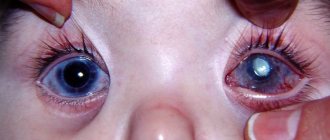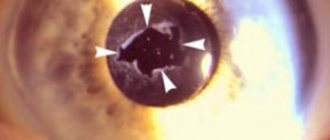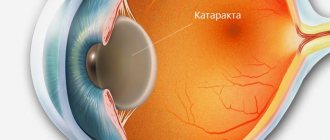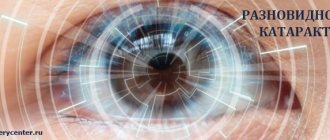What is a cataract?
Typically, our natural eyeball lenses are clear.
They consist mainly of protein and water. As you age, the protein begins to coagulate, creating clouding of the lens. When the lens becomes cloudy, it cannot focus light onto the retina clearly, causing visual blurred vision. Half of the population over 65 years of age has some form of cataract. People over 75 years of age suffer from this disease in 85% of cases. How do people with cataracts see? It's a lot like looking through a frozen window. People with cataracts can see, but they are unable to see clearly. Usually the pathological process progresses with age. The most dangerous consequence of this disease is blindness.
In the early stages of cataracts, ophthalmologists select glasses for their patients and recommend using more light sources so that they can see better. However, there inevitably comes a time when glasses no longer help, and then you will need eye surgery.
Pankov glasses for the treatment of cataracts
This is an effective device for treating the initial stages. The glasses regenerate light pulses using LED emitters. They affect the eye muscles, causing them to contract rhythmically. As a result, the pupil reflexively contracts and expands under the influence of light waves. This promotes the outflow of intraocular moisture, improves lymphatic drainage and activates blood circulation. The lens receives the necessary nutrition. To achieve the maximum therapeutic effect, it is recommended to simultaneously use Pankov glasses and eye drops, which contain vitamins and minerals.
Achieving a therapeutic effect is possible only with long-term use of this device. Sessions must be conducted regularly. The interval between them should be no more than three days. When using the device for the first time, the session lasts no more than three minutes. Then the duration can be gradually increased. The maximum duration of one session is 15 minutes. The course of treatment usually consists of fifteen sessions. Therapy can be repeated at intervals of one month.
Cataract surgery
Cataract surgery is a minimally invasive procedure.
Since eye cataract surgery is still an intervention, many patients try to postpone it. They don't understand: the longer you wait, the denser the cataract becomes, and the more difficult it is for the surgeon to remove it, which can lead to unpleasant consequences and surgical complications. The appropriate time for cataract surgery is determined by the doctor depending on the severity of the disease and the individual characteristics of the person. For some people, despite their age, the disease is not a big problem. However, if it reduces your quality of life, surgery can correct it.
Cataract surgery has made tremendous strides in the past few years. Phacoemulsification is one of the most common eye surgeries and is safe and effective. Eye surgery for cataracts takes less than an hour. But like any other surgical intervention, there are some risks and possible complications. The surgical incisions are very small, recovery is quick, and vision returns very quickly.
If cataracts affect two lenses, surgery is required on both eyes; the interval between interventions can range from several weeks to a month.
If there is still a problem
Clinical manifestations of the disease increase gradually: visual acuity decreases, glare and double vision occur. Doctors recommend surgery when the quality of life begins to suffer. That is, a person experiences difficulties with everyday activities - reading books, driving a car or carrying out professional activities. All preventive measures, be it diet or physical activity, will not help get rid of the problem.
The surgical intervention consists of minimally traumatic removal of the lens and installation of an artificial lens in its place. The entire procedure takes from 30 to 45 minutes, is performed under local anesthesia and involves a quick recovery. After a few hours, the patient is sent home, where he spends the first day alone, following the recommendations of specialists.
Lens extraction is one of the safest operations. Once in the hands of professionals, you can get rid of visual discomfort. And the possibilities of modern microsurgery will make the recovery period quick and comfortable.
Possible consequences of eye cataract surgery
List of possible complications that occur after cataract eye surgery:
- Pain that does not improve with analgesics.
- Blurred vision or loss of vision.
- Double vision.
- Redness of the eyes.
- Bleeding.
- Flashes of light and floating spots.
- Nausea, vomiting, or severe cough.
Some patients may experience minor complications after cataract surgery that resolve on their own over time. However, there are some consequences that, if they occur, should be eliminated within a few weeks. This is swelling of the cornea or retina and increased eye pressure
How to prevent complications
To prevent the development of the disease, it is necessary not only to start treatment in a timely manner, but also to follow a number of preventive measures:
- visit an ophthalmologist once every six months for early diagnosis of cataracts;
- systematically monitor blood sugar levels;
- promptly treat infectious diseases;
- use sunglasses to protect your eyes from ultraviolet radiation;
- eat foods containing antioxidants;
- follow safety rules when using chemicals;
- giving up bad habits and drinking alcohol.
Paying attention to your health will help prevent the development of a dangerous disease. This is especially important for middle-aged and elderly people.
Useful video
Cataracts - symptoms, consequences, treatment methods:
Prices for cataract removal:
| № | Service name | Price in rubles | Make an appointment |
| 2009003 | Optical-reconstructive intervention in the anterior segment of the eye for cataracts and post-traumatic and post-traumatic changes | 90000 | Sign up |
| 2008047 | Phacoemulsification for complicated, mature and overmature cataracts, category 3 of complexity | 86880 | Sign up |
| 2008046 | Phacoemulsification for complicated, mature and overmature cataracts, category 2 of complexity | 79650 | Sign up |
| 2008045 | Phacoemulsification for complicated, mature and overmature cataracts, category 1 of complexity | 77400 | Sign up |
| 2008044 | Phacoemulsification for initial and immature cataracts, category 3 of complexity | 71220 | Sign up |
| 2008043 | Phacoemulsification for initial and immature cataracts, category 2 of complexity | 67080 | Sign up |
| 2014001 | Penetrating keratoplasty + phacoemulsification or cataract extraction with IOL implantation (complexity category 2) | 96000 | Sign up |
| 2014003 | Penetrating keratoplasty + reconstruction of the anterior chamber with iris plastic surgery, phacoemulsification or cataract extraction with IOL implantation | 120000 | Sign up |
| 2014005 | Deep anterior lamellar keratoplasty + phacoemulsification or cataract extraction with IOL implantation (complexity category 2) | 108000 | Sign up |
| 2014007 | Posterior layered endothelial keratoplasty + phacoemulsification or cataract extraction with IOL implantation | 84000 | Sign up |
| 2008041 | Discision of secondary cataract | 9000 | Sign up |
| 2008053 | A set of consumables and an imported intraocular lens for phacoemulsification of cataracts with cataract removal. | 42000 | Sign up |
| 2008005 | Ultrasound phacoemulsification with IOL implantation for initial and immature age-related cataracts | 79650 | Sign up |
| 2008007 | Ultrasound phacoemulsification with IOL implantation for complicated, mature and overmature age-related cataracts | 84440 | Sign up |
| 2008012 | Cataract removal without phacoemulsification + IOL | 40200 | Sign up |
| 2008021 | Cataract extraction with implantation of an artificial lens of the first category of complexity | 40500 | Sign up |
| 2008022 | Cataract extraction with implantation of an artificial lens of the second category of complexity | 45600 | Sign up |
| 2008023 | Cataract extraction with implantation of an artificial lens of the third category of complexity | 50400 | Sign up |
Making an appointment Today: 17 registered
Lens clouding in older people
According to statistics provided by WHO, about 70% of all cases of age-related cataracts occur over the age of 70 years. This means that the older a person gets, the higher the likelihood of lens clouding.
Despite these data, cataracts are not only a disease of the elderly. The disease does not develop due to the fact of aging, but due to changes that occur in the body with age. Some of these changes may well occur at the age of 40-50, it all depends on the individual characteristics of each person’s body, as well as genetic factors.
In old age, the main reason for the development of pathology is considered to be changes that occur in the lens at the biochemical level. This process is regarded by doctors as natural, that is, every person is susceptible to the development of cataracts to a certain extent.
Diagnostics
The final diagnosis for suspected senile cataracts is made only in the context of an extensive ophthalmological examination, including determination of visual acuity, autorefractometry, ocular biomicroscopy, ocular tonometry and other standard methods. Optical coherence tomography, a high-tech technique with the latest software support, helps improve diagnostic accuracy. Layer-by-layer non-invasive scanning of eye structures allows the doctor to determine the degree of lens opacification, establish the type of cataract, identify associated pathologies and predict treatment results. The LenStar non-contact optical biometer accurately calculates the characteristics of the future artificial lens with micron accuracy. Upon completion of the diagnosis, the doctor offers the optimal treatment tactics for age-related cataracts, taking into account the clinical picture of the disease, individual needs and professional activities of the patient.
Characteristic symptoms
It is impossible to insure against cataracts in old age - age-related changes sooner or later make themselves felt, even if vision has remained clear over previous years. The main problem of patients with a cloudy lens is that surrounding objects are seen blurry, foggy, with cloudy spots superimposed on the picture.
The clinical picture consists of several symptoms:
- Decreased visual acuity that cannot be corrected with glasses;
- Double vision when viewing an object with one eye;
- Increased photosensitivity;
- The occurrence of glare, flashes from light sources;
- Deterioration of vision in low light;
- Difficulty recognizing colors and shades.
Advanced forms of age-related cataracts lead to patients losing the ability to see objects and color perception. All that remains is light perception and the ability to weakly distinguish silhouettes without the possibility of glasses correction.
Causes of cataracts in old age
The structure of the natural lens is unique - it is a real biological lens, consisting of water, protein compounds and minerals. The lens is completely transparent, there are no vessels or nerve endings in it, and it receives nutrition from the intraocular fluid, which is constantly produced in the eye. With age, metabolic processes slow down, metabolic products and toxins are not eliminated as quickly as before. The nutrition of the lens is disrupted, and the destruction of transparent proteins begins. Loss of structure leads to loss of transparency (an analogy can be drawn with egg white, which turns white and thickens during denaturation). Cloudiness that appears on the lens is a cataract, causing progressive deterioration of vision. The disease can develop as a result of injury or against the background of systemic diseases.
Factors contributing to the appearance of senile cataracts:
- Diabetes;
- Hypertonic disease;
- Increased intraocular pressure;
- Hormonal disorders.
Risks increase with bad habits, radiation exposure, regular use of certain medications, unfavorable ecology, work in hazardous industries, and intoxication with toxic substances.
How quickly does a cataract mature?
The early stages of progression of the pathological process often go unnoticed due to the absence of any symptoms. This is explained by two features of the development of cataracts:
- the pathology develops slowly; several years may pass from the moment of its occurrence to the appearance of the first clinical signs;
- in most cases, clouding of the lens begins at the edges, that is, the affected areas are outside the optical zone, the clarity of vision remains the same up to a certain point.
The process of cataracts progressing to a severe stage, loss of vision, can take several years. During this period, vision will gradually deteriorate, leading to overripe cataracts. In this case, the patient only has a feeling of light (patients understand whether it is dark or light around). At the final stages of pathology progression, the color of the pupil changes, which is visible even with the naked eye (from black to various shades of white or light gray).











